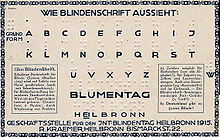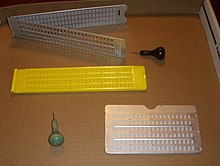Braille



As Braille systems from across characters referred to by the blind can be read. Reading is done with the sense of touch of the fingers, with which the raised structures of the characters can be distinguished from their planar surroundings and identified. There are several such systems of braille, of which the year today in 1825 by Louis Braille developed Braille is the most widespread.
Many of these writing systems for the blind are well thought out, but often have the disadvantage that they are used by the sighted for the blind, e.g. B. the moon alphabet . Not so with Braille, which was developed by its namesake, who was blind himself, as a practicable writing system for blind people.
To differentiate between Braille and Braille, the term black script is often used for the script of the sighted .
Basic explanations
There are two main directions in Braille:
- Relief writing in which the normal Latin letters or simplified graphic patterns are made palpable (e.g. the moon alphabet ), and the
- Braille that reproduces the letters in a dot grid or translates them into a code .
Braille
Dot fonts are fonts that consist of raised points protruding from the material and thus tangible. The first of these typefaces, which consisted of tactile dots and lines , was designed by Francesco Lana Terzi in 1670 , but it was never used. In 1815 , Charles Barbier developed his military-style night writing that was supposed to be legible in the dark. Since this font did not reach the military, it offered barber in the Paris school for the blind.
Braille is used synonymously for normal Braille , which uses six dots. This is by far the most widespread and best-known braille, but there are also other braille systems. Before Braille became generally accepted, the New York Point developed by William Bell Wait (also known as Wait for short ) was widespread in North America . In addition, computer braille , which uses an 8-point system to make it easier to display capital letters and special characters, or 7-point and 8-point stenography for the blind, has become popular. “Computer Braille” is mainly used for Braille displays that blind people can use to read the content of a computer screen.
Braille is put on paper with special Braille printers or dot type machines . The space requirement of the braille systems is enormous, because the characters are larger than in black letters. The paper also has to be much thicker in order to be able to be embossed permanently. The Duden thus comprises 18 volumes in braille. It is at least possible to emboss the sides on both sides with machine production, because the fingers only feel the bumps, but not the depressions. To do this, the characters on the front and back must be offset from one another by a small amount, so that points that have already been pressed out on one side are not pushed in again from the other. In order to compensate for the disadvantages caused by the heavy weight of Braille printed matter in letter correspondence, Deutsche Post AG transports items in Braille free of charge (marking: blind items / cécograms ).
Braille continues to spread. According to the 12th amendment to the AMG ( Medicines Act ) since 2004, all pharmaceutical packaging in Germany must also be provided with Braille.
Creating Braille
Analogous to black writing, which is shown permanently by handwriting or printing on paper or temporarily on displays and screens, for example, braille can also be shown temporarily with Braille or permanently embossed on paper / cardboard.
The permanent display is usually made on cardboard or somewhat thicker paper. Other options are metal plates with dot-letters in elevators or plastic foils for labeling. There are different ways to write braille (especially Braille ) permanently:
- Braille board : The Braille letters are pressed into the paper from the back with a stylus. These are still widespread today because they offer many advantages (handy for traveling, very robust, etc.). Presumably the braille table helped braille to make a breakthrough over relief writing, because it made it very easy to create documents. This is much more complex with relief writing.
- Braille machine : Each key is assigned a point of the Braille letter. The keys required to generate a letter are pressed simultaneously.
- Braille displays : The letters are entered using either six or eight keys for computer Braille, similar to the braille machine, or directly using a connected computer keyboard (each letter is assigned a key). The Braille characters are output dynamically via the Braille line.
Braille in public facilities and train stations

The Deutsche Bundesbahn equips many handrails of the train stations with Braille.
See also
- Braille music writing
- Braille translation program
- Libraries for the blind , institutions spread around the world, mostly on a non-profit basis with government support
literature
- Bernhard Walter Panek: Braille: writing - graphics - printing. Production and reproduction of tactile publications. Wiener Universitätsverlag ISBN 978-3-7089-0153-4
- Kai Nonnenmacher: Animated language, sublime writing - anaglyptography and literary blindness in French romanticism. In: Claudia Gronemann Ed .: Body and Writing: Contributions to the 16th Colloquium for Young People in Romance Studies. Leipzig, June 14-17 , 2000. Forum Junge Romanistik, 7. Romanistischer Verlag, Bonn 2001 ISBN 3-86143-122-X pp. 393-409
Web links
- braille.ch presents various Braille systems from other countries, e.g. B. Chinese
- Chronological development of the Braille scripts (chronological table) including writings by Terzi, Haüy, Klein, Lucas, Gall, Howe, Alston, Moon, Hebold, Wait, Smith, Mascaró, on fakoo.de
- Virtual exhibition "Signs - Books - Networks" of the German Museum of Books and Writing : Braille , with video interview with Prof. Thomas Kahlisch on the function and history of Braille
- Tools
- Online Braille translator of the Christoffel Blindenmission
- Learn Braille online , convert your own texts into Braille, braille board simulator and more at fakoo.de
- The system of German Braille , Deutsche Blindenstudienanstalt Marburg 2005. Comparison of different versions, reformed shorthand, since the 1970s, valid for Germany, Austria and German-speaking Switzerland through international treaties. Series: Marburg Systematics of Braille
- Literature sources
- blindenschrift.net with u. a. Online catalog with all braille books in German
- Braille.ch rules and textbooks
- Library for the blind of the German Central Library for the Blind, based in Leipzig (DZB).
Individual evidence
- ↑ Terzis Braille at www.fakoo.de
- ↑ Barbiers Nachtschrift at www.fakoo.de

